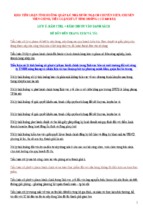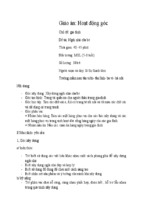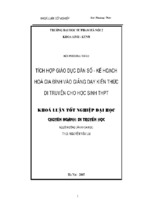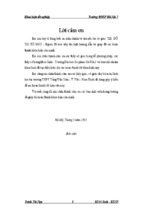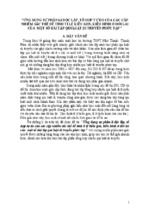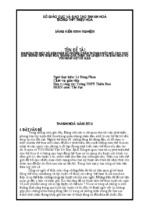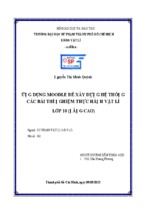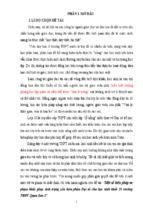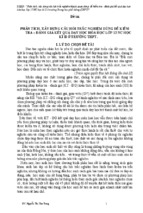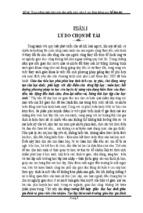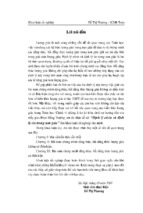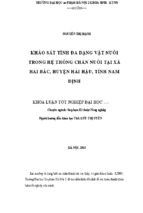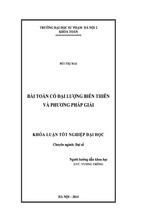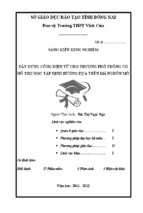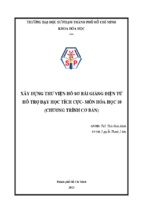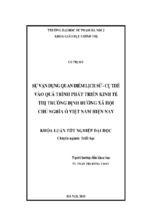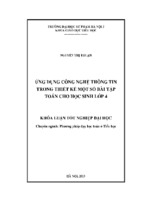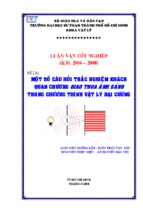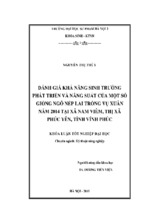SỞ GIÁO DỤC – ĐÀO TẠO BÌNH ĐỊNH
TRƯỜNG THPT SỐ 1 TUY PHƯỚC
Giáo viên thực hiện
: Nguyễn Thị Hồng Minh
Tổ
: Ngoại Ngữ
- Tuy Phước, Tháng 5 năm 2011 -
THE
USES
OF
ADJECTIVES AND ADJECTIVE
PHRASES IN ENGLISH
TABLE OF CONTENTS
PART I: INTRODUCTION……….……………………………........................................... 1
1.1 Background and the reason for the study …………………………..…………….…..…1
1.2. Aims of the study…………………………………………………………………………………….…….......1
1.3. Methods of the study………………………………………………………………………………..…..... 2
1.4 Design and rationale of the study…………………….……….……………………………..… 2
PART II: INVESTIGATION AND APPLICATION………………………….…..……2
I. THEORETICAL BACKGROUND……………………………………..……………………………….………..3
2.1. Definition of adjectives…..…………………………………………………………………..………….3
2.1.1. Position of adjectives……..……………………………………………...….2
2.1.2. Position : attributive only……………………………………………………….…………........4
2.1.3. Position : predicative only………………….…………..……..………………….……….…...4
2.1.4. Position : immediately after nouns………………………………….……………........5
2.1.5. Position and meaning.………………………………………..……………………..……….……….5
2.1.6. Adjective complementation………………………………………………….…………..….....5
2.1.7. Order of adjectives……………………………………………………...............................6
2.2 Definition of Adjective phrases………………………………………………….……………...7
2.3 The uses of Adjectives and Adjective phrases………………………..……..….…8
2.3.1. The semantic roles of adjectives and adjective phrases………..…...8
2.3.2. The syntactic roles of adjectives and adjective phrases……..……..11
2.4. Teaching Adjectives and Adjective phrases………………………………………..14
2.5 Some basic principles in teaching Adjectives and Adjective phrases……15
* Suggested
Exercises and Keys to the Exercises in
teaching adjectives and adjective phrases……17
III. INVESTIGATION:……….…………………………………………………………………………………………….….23
3.1.The subject……………………..…..……………………………………………………………….………......23
3.2. Data collection………………………………………………………………………………………………...23
3.2.1. The questionaires…..…..…….…………………………………………….………………..……...23
3.2.2.The Class observation………..…………………………………………...………………..….....23
3.3. Data Analysis…………………………..………………..……………………………………..………..……23
IV. Suggested
some techniques or activities in teaching
adjectives and adjective phrases….25
V. APPLICATION.………………………………..………………………………....................….................30
Illustration 1………………………………………………………………...........................……………..31
Illustration 2………………………………..…..……………….....................……………....……..……35
PART III: CONCLUSION…………..……………………………………......…....40
Suggestions
REFERENCES ……………...…………............……………......…...41
Appendix. Survey Questionaires…………..........................…………………42
Page 2
By Nguyen Thi Hong Minh – From Tuy Phuoc I High School
THE
USES
OF
ADJECTIVES AND ADJECTIVE
PHRASES IN ENGLISH
PART I
INTRODUCTION
1.1 Background
and the reason for the study:
When you read a composition or a story, you sometimes utter “How good is it!”.
Apart from the content, there are some other factors greatly contributing to the effectiveness
of writing.
Very often we do not realize the importance of the things we see everyday. The
Adjectives and Adjective phrases are one of such those things.
Have you ever seen a text without adjective phrases ? or Have you ever paid much
attention to the most common pre-modifying type of noun phrases?
Now, we have a look at the following story.
“ It’s illegal to drive under the age of seventeen in Britain, but a 17-year-old boy
managed to pass his driving on the day of his seventeenth birthday. Most people would
consider this impossible because you need a lot of lessons to pass the test. David Livesery
arranged to have an eight-hour lesson beginning at dawn on his birthday. At first he was
very careful and hesitant, but he had a wonderful teacher and his driving improved
amazingly during the day. By four in the afternoon,still feeling energetic, he was ready to
take his test and he drive home very slowly in the reddish light of the setting sun. David’s
driving attracted the attention of two policemen, but they broke into smiles and congratulated
him warmly when he showed them his certificate and told them his story.
With the appearance of the Adjectives and Adjective phrases , the above story either
makes you interested or makes an impression on you, doesn’t it ?
Obviously, to make good use of English as much as possible, people are required to
master all aspects of English, both a complicated system of structures and that of
vocabularies.
In English, Adjectives and Adjective phrases is a neither small nor simple category.
Due to its different functions by syntax and by semantic, the Adjective phrase is both of great
occurrence in all kinds of writing and plays an important role in making good essays,
especially descriptive compositions. Moreover, it is said that the Vietnamese language is
plentiful and various.Therefore, the Adjectives and Adjective phrases themselves make a
contribution to the variety and richness of the language.
On the whole, using adjective phrases are quite common and advantageous.
The most important reason why I vote for this study has derived from the mistakes
my students have made while they are speaking and writing .
Owing to the above reasons, I have made up my mind to choose “The uses of
Adjectives and Adjective phrases in English” as my topic of the study.
1.2 Aims of the study:
With the reasons above in my mind, the specific aims of the study accordingly are:
+ To present the uses of Adjectives and Adjective phrases and Vietnamese
equivalents.
+To point out some similarities and differences in the uses of Adjectives and
Adjective phrases.
Page 3
By Nguyen Thi Hong Minh – From Tuy Phuoc I High School
THE
USES
OF
ADJECTIVES AND ADJECTIVE
PHRASES IN ENGLISH
+ To suggest some techniques in teaching Adjectives and Adjective phrases.
+ To give out some practical exercises for the further understanding of the English
Adjective phrases.
In the limitation of time, I intend to deal with something about the theory of the
Adjectives and Adjective phrases in English and point out some similarities and differrnces
in the uses of Adjectives and Adjective phrases to help English learners to make good use of
them.
I am not planning on studying a larger population, just the population at a high school .
1.3. Methods of the study :
* A study on theoretical background from Methodological books and materials.
* Survey questionnaire.
* Personal observations by attending classes.
1.4. Design
and rationale of the study :
* This study consists of 3 parts and an appendix:
1. Part I is the introduction.
2. Part II is the theoretical background; the investigation and application .
3. Part III is the conclusion. The Reference and Appendix are the last parts of the study
* Data collections for analysis in this study come from students of Tuy Phuoc I High
school: 50 students from the eleventh form and 50 students from the twelveth form.
PART II
INVESTIGATION AND APPLICATION
I. THEORETICAL BACKGROUND
2.1 Definition of
Adjectives :
The book critic R. Z Sheppard once remarked that adjectives “are the potbelly of
poetry”.
Many English language teachers would not take such a disparaging view.
Adjectives are often quite fun to teach and the rules surrounding them are, usually, quite
straightforward. This month’s article is the first of two in which we throw the spotlight on
adjectives. We start by looking at adjectives in relation to the wider phrasal structures they
occur in, examining issues of position, complementation, and ordering.
When we want to give more information than can be provided by using a noun alone,
we can add an adjective to identify a person or thing, or describe them in more detail, e.g.:
her new dress
a kind person
the phonetic alphabet
accuracy is important
Note that sometimes nouns can be placed before other nouns as a way of identifying a
particular type of person or thing, e.g.:
Page 4
By Nguyen Thi Hong Minh – From Tuy Phuoc I High School
THE
USES
OF
ADJECTIVES AND ADJECTIVE
PHRASES IN ENGLISH
a chocolate cake
the football player
Nouns used in this way are usually referred to as noun modifiers. Though they are
functioning in a similar way to some adjectives, we classify them as nouns. Examples like
this are often referred to as compound nouns, with the first noun identifying a particular type
in relation to the group of people or things described by the second noun.In the following
article, we will focus on true adjectives, rather than noun modifiers.
2.1.1. Position of adjectives:
Most adjectives can appear before a noun as part of a noun phrase, placed after
determiners or numbers if there are any, and immediately before the noun, e.g.:
She had a beautiful smile
He bought two brown bread rolls.
Adjectives placed before a noun in this way are generally referred to as occurring in
the attributive position.
Most adjectives can also occur as complements of the verb be and other link verbs
such as become, feel or seem, e.g.:
Her smile is beautiful.
She didn’t seem happy.
Adjectives placed after the verb in this way are generally referred to as occurring in
the predicative position.
When the information contained in an adjective is not the main focus of a statement,
then the adjective is usually placed before the noun in the attributive position.
However, when the main focus of a statement is to give the information contained in
an adjective, the adjective is usually placed after the verb in the predicative position,
compare:
He handed me a bucket of hot water. (attributive position)
I put my hand in the bucket, the water was very hot. (predicative position,
emphasising hot.)
Though most adjectives can be used in both the attributive and predicative positions,
there are a number of adjectives that can occur in one particular position only, as described
below:
2.1.2. Position: attributive only
There are some adjectives which can only be used before a noun, in the attributive
position. For instance, “We talk about the main problem” but cannot say “The problem was
main”.
Adjectives which occur only in the attributive position are generally those which
identify something as being of a particular type. For instance, we can talk about a financial
decision where financial distinguishes this from other types of decision, e.g.: medical,
political. This group of adjectives are often referred to as classifying adjectives, and rarely
occur in the predicative position unless we specifically want to emphasise a contrast, e.g.:
Page 5
By Nguyen Thi Hong Minh – From Tuy Phuoc I High School
THE
USES
OF
ADJECTIVES AND ADJECTIVE
PHRASES IN ENGLISH
a chemical reaction not, e.g.: a reaction which was/is chemical
the phonetic alphabet not, e.g.: the alphabet is phonetic
It was an indoor pool. not, e.g.: The pool was indoor
Other adjectives which generally appear in the attributive position are those which are
used for emphasis, e.g.:
The show was absolute/utter rubbish.
You made me look a complete fool.
The project was a total disaster.
2.1.3. Position: predicative only
There are some adjectives which only usually occur in the predicative position, as
complements of be or other link verbs. For instance, you can say He felt glad. but wouldn’t
normally talk about a glad person.
Adjectives which usually occur in the predicative position include those which
describe feelings, such as afraid, content, glad, ready, sure, sorry and upset, e.g.:
She felt afraid. but not, e.g.: an afraid girl
My daughter is upset. but not, e.g.: my upset daughter
They also include a group of adjectives with prefix a-, such as asleep, alive, alone,
ashamed, awake, aware, e.g.:
I like being alone. but not, e.g.: I like being an alone person.
The baby’s asleep. but not, e.g.: the asleep baby.
2.1.4. Position: immediately after nouns
Some adjectives that describe size or age can occur immediately after a noun that
indicates a unit of measurement, e.g.:
She was about five feet tall
Her baby is ten months old.
The walls were six inches thick.
There is a small group of adjectives, sometimes referred to as post nominal adjectives,
which can only occur immediately after a noun. Examples are:
the president elect
the devil incarnate
Many other adjectives can be used immediately after a noun when they form part of a
(reduced) relative clause, e.g.:
Let’s use the time available.
Is she someone capable of making difficult decisions?
I’d like to speak to all the people involved.
2.1.5. Position and meaning
There are some adjectives which can occur either before or after a noun, but the
position they occur in has an effect on their meaning, e.g.:
Page 6
By Nguyen Thi Hong Minh – From Tuy Phuoc I High School
THE
USES
OF
ADJECTIVES AND ADJECTIVE
PHRASES IN ENGLISH
the concerned parents (= ‘the parents who are worried’)
the parents concerned (= ‘the parents who are involved/mentioned’)
the present situation (= ‘the situation which exists now’)
the people present (= ‘the people who are here/there’).
a responsible person (= ‘a person who is sensible/reliable’)
the person responsible (= ‘the person who is to blame or has
responsibility for something’)
2.1. 6. Adjective complementation
When adjectives occur in the predicative position, after be or other link verbs, they are
sometimes followed by a prepositional phrase or verbal complement. Some typical examples
are summarised in the table below:
Patterns
Adjective + of
Adjective + to
Adjective + with
Adjective + on
Typical adjectives
aware,
proud,
capable
kind,
sensitive,
similar, equal
angry,
impatient,
honest
keen,
gentle,
dependent
Adjective + in
interested,
disappointed
Adjective + about
pleased,
anxious
difficult,
ready
worried,
confident, sure
Adjective + to-infinitive
Adjective + that-clause
Examples
was proud of
She
her
son.
Her house is similar to
mine.
I felt angry with him.
He’s totally dependent
on his parents.
We’re not interested in
selling our house.
glad, She was anxious about
the results.
easy, The book was easy to
read.
Adjective + wh-clause
unsure, uncertain
Adjective + -ing
busy,
awkward
I’m
confident
that
she’ll succeed.
He was uncertain what to
do next.
silly, They’re
busy
the kitchen.
painting
2.1.7. Order of adjectives
Adjectives describing the main characteristics of a person or thing are often grouped
together before the noun they describe, e.g.:
a beautiful young woman
a large round table
Page 7
By Nguyen Thi Hong Minh – From Tuy Phuoc I High School
THE
USES
OF
ADJECTIVES AND ADJECTIVE
PHRASES IN ENGLISH
Two or three descriptive adjectives are often used together in this way, though note
that placing more than three adjectives before a noun would start to sound unnatural, e.g.:
a beautiful wooden table
sounds fine, but a structure like:
a beautiful large round carved wooden table
though grammatical, would not normally occur in everyday speech or writing.Descriptive
adjectives used in this way belong to seven main types. The table below summarises the
types and the usual order in which they appear if more than one adjective is placed before a
noun:
1st 2nd 3rd 4th 5th 6th 7th
opinion size age shape colour origin material
lovely big old triangular white Italian wooden
For example, if you wanted to use an adjective referring to size and an adjective
referring to shape, you would put the size adjective first, e.g.:
a large round table
Similarly, an age adjective would normally be placed before an origin adjective, e.g.:
a young Italian woman
An opinion adjective would occur before a shape or colour adjective, and a shape or
colour adjective would occur before a material adjective, e.g.:
a beautiful green silk dress
If two colour adjectives are used, then and is placed between them, e.g.:
She was wearing a long black and gold scarf.
If three colour adjectives occur, a comma is placed after the first and the last two are linked
with and, e.g.:
The table was covered by a large red, white and blue flag.
As a general rule, the adjective which is closest to the noun is the most closely linked
to the meaning of the noun, describing a feature which is the most permanent about it,
compared to adjectives which express a variable characteristic, such as an opinion. For
instance, if we consider:
an expensive/cheap/beautiful black leather bag
the ‘leather-ness’ of the bag is a more essential characteristic than ‘cost’ or ‘appearance’.
If more than one adjective occurs which expresses an opinion or describes a general
quality, then the adjective with a more general meaning, e.g.: nice, bad usually precedes the
one with a more specific meaning, e.g.: comfortable, clean, for example:
a lovely soft blanket
If two adjectives with similar meanings are used, the shorter one often comes first, e.g.:
a soft comfortable pillow
Page 8
By Nguyen Thi Hong Minh – From Tuy Phuoc I High School
THE
USES
OF
ADJECTIVES AND ADJECTIVE
PHRASES IN ENGLISH
The conjunction but is sometimes placed between two adjectives which describe contrasting
qualities, e.g.:
a difficult but rewarding job
The order of adjectives in predicative position, i.e.: after the verb be or link verbs such
as seem or feel, is less fixed than the order before a noun. The conjunction and is generally
used to link adjectives in this position, occurring before the last adjective used, e.g.:
The room was small and dirty.
He felt cold, wet and hungry.
Adjectives expressing opinion are often placed last, e.g.:
Annabel was young, tall and beautiful.
If we want to imply a contrast between adjectives, the conjunction but is sometimes used,
e.g.:
The flat was small but comfortable.
2.2 Definition of
Adjective phrases:
First of all, let’s have a look at the definition of phrases and adjectival phrases .
Phrases are considered as the second level of classification as they tend to be larger
than individual words, but are smaller than sentences. We refer to the central element in a
phrase as the head of the phrase. If the head is a noun then the phrase is called a noun phrase.
Adjectival phrases are composed of the adjectives that modify a noun and any adverbs
or other elements that modify those adjectives. Adjectival phrases always occur inside noun
phrases or as predicate adjectives.
Example: Dad bought [(a blue and green) sweater]
The adjective phrase is a phrase that functions as an adjective:
The brothers were always quarrelsome.
[ 14;13]
Or the adjective phrase is a phrase in which the adjective is the head:
They were quite unware of any wrongdoing.
In order to make adjective phrases more simple and convenient to research, I’d like to
give out the definition of an adjective phrase as follows:
An adjective phrase is a word or a group of words functioning in a sentence like an
adjective. It contains an adjective as the head optionally accompanied by modifiers in the
form of single words, phrases or clauses.
2.3
The uses
phrases:
of
Adjectives
and
Adjective
Adjectives and adjective phrases are of common occurrence. To make good use of
adjectives and adjective phrases, it is necessary to know well about the following:
2.3.1. The semantic roles of adjectives and adjective phrases :
It is said that the adjective is the “soul” of an adjective phrases. Therefore, in order to
research more convenient we consider that the semantic roles of adjective phrases are like
those of adjectives.
Page 9
By Nguyen Thi Hong Minh – From Tuy Phuoc I High School
THE
USES
OF
ADJECTIVES AND ADJECTIVE
PHRASES IN ENGLISH
Semantically, R.Quirk and S.Greenbaun divided adjectives into subclasses: (1)stative
verus dynamic adjectives, (2) gradable verus non-gradable adjectives. (3) inherent verus noninherent adjectives.
(1) Stative verus dynamic adjectives:
A Stative adjective
He’s being tall
careful
Be tall
A Dynamic adjective
He’s
being
Be careful
Adjectives that can be used dynamic include: awkard, brave,calm,careless,
cruel,extravagant, foolish,funny, good,impudent, irritable,jealous,naughty,noisy,and rude.
Stative adjectives include: kind,lazy,stupid,generous, obstinate, tactful,
interesting,busy.
(2) Gradable verus non-gradable adjectives:
Most adjectives are gradable, that is to say, can be modified by adverbs which convey
the degree of intensity of the adjective. Gradability includes comparison:
tall
taller
tallest
beautiful
more beautiful
most beautiful
And other forms of intensification:
very young
so plain
extremely useful
All dynamic adjectives are gradable. Most stative adjectives (tall,old) are gradable,
some are non-gradable, principally “technical adjectives” like atomic (scientist) and
hydrochloric (acid) and adjectives denoting provenance, e.g.: British.
(3) Inherent verus non-inherent adjectives.
Adjectives that characterize the referent of the noun directly are termed
INHERENT; those that do not are termed NON-INHERENT.
Most adjectives are inherent, and it is especially uncommon for dynamic adjectives
to be other than inherent, an exception is “wooden” in the actor is being wooden.,whicj is
dynamic and non-inherent.
Whether or not an adjective is inherent or non-inherent, it may involve relation to
an implicit or explicit standard. “ Big” is inherent in “ a big mouse”, the standard being
the relative size of mice, contrast “a little mouse”. “Big” is non-inherent in “a big fool”,
the standard being degree of foolishness, contrast “a big of a fool”. The relative standard
is to be distinguished from gradability as well as from the inherent/non-inherent contrast.
For example, “perfect” and “good” are non-inherent in “a perfect mother” and “ a
good mother” , the standard being motherhood, but only good is gradable ( a very good
mother, a very perfect mother). Similarly, though the inherent “big” in “ a big elephant”
is gradable (a very big elephant), the inherent adjective in an enormous noun is not
gradable ( a very enormous noun)
In another aspect, Randolph.Quirk distinguishes two broad semantic groups of
adjectives: descriptors and classifiers. Descriptors are prototypal adjectives denoting such
features as color, size, and weight, chronology and age, emotion and a wide range of other
characteristics. They are typically gradable. In contrast, the primary function of classifiers is
to delimit or restrict a noun’s referent, by placing it in a category in relation to other
referents. They are typically non-gradable. Classifiers can be grouped into subclasses,
Page 10
By Nguyen Thi Hong Minh – From Tuy Phuoc I High School
THE
USES
OF
ADJECTIVES AND ADJECTIVE
PHRASES IN ENGLISH
including relational, afflictive and a miscellaneous topical class. Classifiers can be more or
less descriptive content while many topical classifiers (such as chemical, medical,political)
provide descriptive content while also limiting the reference of the head noun.
Selected examples of adjectives belonging to these semantic domains are:
(1) Descriptors:
Descriptors can be divided into subclasses, including:
+ COLOR- denoting color,brightness: black,white,dark,bright,blue,brown,green,grey,red.
Eg: The passenger turned quite green with sea-sick.
Life seemed grey and pointless after she’d gone.
+ SIZE/QUANTITY/EXTENT-denoting
size,weight,extent:big,deep,heavy,huge,long,large,little,short,small,thin,wide.
Eg: Lead is a heavy metal
You’ve cut my hair very short.
+ TIME- denoting chronology, age, frequency: annual,daily,early,late,new,old,recent,young.
Eg: There is an early train every Saturday.
Ours is a recent accquaintance.
+ EVALUATIVE/EMOTIVE- denoting judment, affect,emphasis:
bad,beautiful,best,fine,good,great,lovely,nice,poor.
Eg: The car has very good brakes.
+ MISCELLANEOUS DESCRIPTIVE- appropriate,
cold,complex,dead,empty,free,hard,hot,open,possitive,practical,pirate,serious,strange,strong
,sudden.
Eg: That’s a good film.
Especially if you can get the right price.
(2) Classifiers
Classifiers can be grouped into subclasses:
+ RELATIONAL/CLASSIFICATIONAL/RESTRICTIVE- delimiting the referent of a
noun, particularly in relation to other referents:
additional,overage,chief,complete,different,direct,entire,external,final,following,general,
initial,internal,left,main,maximum,necessary,original,particular,previous,primary,public,
similar,single,standard,top,various,same.
+ AFFILIATIVE- designing the national or religious group to which a referent belongs:
American,Chinese,Christian,English,French, German,Irish,united.
+ TOPICAL/OTHER (e.g. giving the subject area or showing a relationaship with a noun):
chemical,commercial,environmental,human,industrial,legal,medical,mental,official,oral,
phonetics,political,sexual,social,ventral,visual.
In the following excerpt, descriptor adjectives are underlined with classifiers marked
by [ ]
It has never lost an artist from its record label, supposedly because it consists of many
small and friendly [individual] companies(…)
Fujisankei,itself privately owned and independent,seems the ideal partner.
But the question must remain as to whether a [Japanese] giant with five times the
turnover of the Virgin group will be content to stay a minority player in the long
term. (news)
Some adjectives can serve as either classifiers or descriptors. Below, the expressions
in the left-hand column contain a classifying or restricting adjective, while those in the right Page 11
By Nguyen Thi Hong Minh – From Tuy Phuoc I High School
THE
USES
OF
ADJECTIVES AND ADJECTIVE
PHRASES IN ENGLISH
hand column a descriptor. It is noted that the desriptors are gradable and can be modified to
show degree or extent. E.g.:by very.
Classifier
Descriptor
modern algebra
some modern authorities
criminal law
criminal activity
a secondary school
a useful secondary function
Very common adjective typically designate a range of meanings. For example, in
some expressions old is descriptive, denoting age (an old radio,old newspapers). In others, it
denotes affect (poor old Rusty,good old genetics). Similarly “ poor” has two principal uses:
emotive (the poor devil, You poor bunny!) and descriptive (a poor country, in poor health).
Even the descriptive uses of poor carry: different denotations such as “ lacking adequate
financial resources” and “ not good”.
2.3.2. The syntactic roles of adjectives and adjective phrases :
Adjectives function syntactically only in adjective phrases, but since it is the
adjective that generally determines the funtion of adjective phrases, we have found it
convenient to use adjectives alone to illustrate the functions of adjective phrases and we have
often referred to adjectives as a shorter way of referring to adjective phrases.
The functions of adjectives and adjective phrases in phrases can be shown in the
following table:
(pre-modifier(s))
ADJECTIVES
(post-modifier(s))
good, nice, rich, happy,
adverb (intensifier), e.g. very / wide, bright, uncertain,
prepositional phrase, e.g. at
perfectly / extremely
possible, glad, busy, easier, maths, about this
worse, better
adverb (viewpoint), e.g.
technically / theoretically
noun, e.g. sixteen feet / two
kilometres
adverb, enough / indeed
that-clause, e.g. that you’re
careful
to-infinitive clause, e.g. to hear
from you
-ing-clause, e.g. handing out
letters
comparative clause, e.g. than
they say
Examples of postadjectival modification:
by a prepositional phrase: e.g. conscious of, fond of, happy about, good at, sorry for,
different from, due to, happy with, etc. (for lists of prepositions following adjectives,
see grammar books; dictionaries also give structural information on the use of
adjectives)
by a finite that-clause:
We were confident that Karen was still alive. Many adjectives expressing certainty or
confidence, such as aware, certain, confident, sure can be used in this way.
Page 12
By Nguyen Thi Hong Minh – From Tuy Phuoc I High School
THE
USES
OF
ADJECTIVES AND ADJECTIVE
PHRASES IN ENGLISH
I am anxious that he be/shoud be/?is permitted to resign. Many adjectives expressing
volition, like anxious, eager, willing are used with a subjunctive or putative should in the
that-clause.
by a to-infinitive clause: Bob is slow to react. Bob is sorry to hear it. Bob is hard to
convince. Those darts are awkward for a beginner to use.
by an ing-clause: I'm busy (with) getting the house redecorated. We're fortunate (in)
having Aunt Agatha as a baby-sitter.
by a comparative clause: It was easier than they say.
On a sentence or clause level you can find adjective phrases in the following syntactic
functions:
Subject complement: John was extremely rich indeed / most greatful for your help /
busy handing out letters / uncertain what to do / glad to hear from you / better than
they say.
Object complement: He’s opening his mouth very wide.
You can also find adjectives and adjectives phrases within other phrases:
Premodifier of a noun: Well, he’s [a perfectly nice lad].
Postmodifier of a pronoun: Was there [anything nice]?
Postmodifier of a noun: London is [a city bright with lights].
Complement of a preposition: The insults continued [in private].
The following article explains three functions of adjectives and adjective phrases in the
English language that students must learn.
Adjectives and adjective phrases perform three main grammatical functions within
sentences in the English language. Both native speakers and ESL students must learn and
understand the three functions to use adjectives and adjective phrases correctly in both
spoken and written English. The three functions of adjectives and adjective phrases are:
1. Noun phrase modifier
2. Predicate adjective
3. Object complement
Adjectives are traditionally defined as "words that describe nouns." Adjective phrases
are defined as phrases that consist of an adjective plus any modifiers or complements such as
Page 13
By Nguyen Thi Hong Minh – From Tuy Phuoc I High School
THE
USES
OF
ADJECTIVES AND ADJECTIVE
PHRASES IN ENGLISH
adverbs and prepositional phrases. For example, the phrases blue, very sad, and afraid of the
dark are all adjective phrases.
Adjectives as Noun Phrase Modifiers
The first grammatical function that adjectives and adjective phrases can perform is the
noun phrase modifier. Noun phrase modifiers are defined as words and phrases that describe
a noun or noun phrase. For example, the following italicized adjectives and adjective
phrases function as noun phrase modifiers:
My mother planted purple flowers in her garden.
The very tiny puppy barked at the cat.
The restaurant served plain, tasteless soup.
George Washington appointed Edmund Randolph Attorney General.
Barack Obama was the president elect.
Adjectives as Predicate Adjectives
The second grammatical function that adjectives and adjective phrases can perform is the
predicate adjective. Predicate adjectives are defined as adjectives and adjective phrases that
follow a copular or linking verb such as be and become and modifies or describes the subject.
For example, the following italicized adjectives and adjective phrases function as predicate
adjectives:
Under the bed is filthy.
The cake tastes sickeningly sweet.
My cat is black and brown.
Your perfume smells especially musky but very nice.
I am fond of English grammar.
Adjectives as Object Complements
The third grammatical function that adjectives and adjective phrases can perform is the
object complement. Object complements are defined as nouns, pronouns, noun phrases,
adjectives, and adjective phrases that directly follow and modify the direct object. For
By Nguyen Thi Hong Minh – From Tuy Phuoc I High School
Page 14
THE
USES
OF
ADJECTIVES AND ADJECTIVE
PHRASES IN ENGLISH
example, the following italicized adjectives and adjective phrases function as object
complements:
The farmer painted the barn red.
The little girl wanted her room bright pink.
Catholics consider saints holy.
The jury judged the defendant guilty.
My puppy makes me happy.
Although not accepted in standard English, adjectives and adjective phrases also function
as verb phrase modifiers and adverbials. For example, the adjective phrase too loud in the
sentence He plays his music too loud functions as an adverbial. However, standard
prescriptive grammar rules dictate that only the adverb phrase too loudly should function as
the adverbial in this instance. Another example is the adjective careful functioning as a verb
phrase modifier in the sentence Drive careful. Again, prescriptive rules state that the adverb
carefully should function as the verb phrase modifier. However, the use of adjectives and
adjective phrases as verb phrase modifiers and adverbials is accepted in many forms of
spoken English.
The three functions of adjectives and adjective phrases in the English language are
noun phrase modifier, predicate adjective, and object complement. Both native speakers and
ESL students must learn and understand the three functions to properly and fully use
adjectives and adjective phrases in both spoken and written English.
Hopper, Paul J. A Short Course in Grammar. W.W. Norton & Company: New York, 1999.
Huddleston, Rodney. Introduction to the Grammar of English. Cambridge University
Press: Cambridge, 1984.
Adjective Phrase Noun Phrase
Modifier Grammar Tree
Adjective Phrase Object
Complement
Adjective Phrase
Complement
By Nguyen Thi Hong Minh – From Tuy Phuoc I High School
Page 15
THE
USES
OF
ADJECTIVES AND ADJECTIVE
PHRASES IN ENGLISH
2.4 Teaching Adjectives and Adjective phrases:
The following may be one of the most common ways of teaching Adjectives and
Adjective phrases.
On the same piece of paper, have students write words that describe them and their
personality. It helps if you require students to come up with a specific number of describing
words. For example, I require sophomores to use 30 words to describe themselves as this
requires the students to really involve some higher order thinking skills and be creative to
find words that they may not use every day.
Also, allow students to decorate their shape and allow them to make their project as
representative of their individuality as possible.
Once students have satisfied your requirements, you should explain to them that those
words that describe people, places, and things are called adjectives.
Generally, after completing this project, students understand the differences between
nouns and adjectives, which is the purpose of the teaching adjectives and nouns lesson plan.
But this project really lets students be creative, and in some cases, you will see that students
have the opportunity to increase their vocabulary and use adjectives that they normally do
not use.
Also, students will learn new adjectives from each other as you may not allow
students sitting at the same table to use a word more than once. Teachers have the flexibility
to place their own requirements and limitations on this project.
(Cited from British Council. Methodology )
2.5 Some basic principles in Teaching Adjectives
and Adjective phrases:
Preschoolers and Adjectives
Preschoolers use words to describe people, places, things, ideas, and activities every
day. Although explicit language and grammar instruction typically begins after preschool in
elementary school, preschool aged students can begin to learn about the most basic parts of
speech, or grammatical forms, including nouns, adjectives, and verbs. This lesson plan
outlines activities to teach preschool children that adjectives are words that describe nouns.
Discussion and Prior Knowledge
The teacher can introduce the topic of adjectives to the preschool class by asking the
students the following questions:
1. Do you know what an adjective is?
2. Do you know what it means to describe something?
Most preschoolers will probably answer no to the first question but should be able to
answer the second question. For example, the students might say that describing something
By Nguyen Thi Hong Minh – From Tuy Phuoc I High School
Page 16
THE
USES
OF
ADJECTIVES AND ADJECTIVE
PHRASES IN ENGLISH
means telling about it. The students must have prior knowledge about the concept of
description before continuing with the rest of the adjective lesson plan. If the students cannot
answer question two, then the teacher should review how to describe something.
Reading
After the discussion introducing preschoolers to adjectives, the teacher can read one or
two books about adjectives to the students. Two excellent titles, both by Brian P. Cleary, for
younger students are:
Hairy, Scary, Ordinary: What Is an Adjective?
Quirky, Jerky, Extra Perky: More about Adjectives
Both books talk about adjectives as words that describe things, ideas, and living beings,
or, in other words, nouns. The preschoolers will love the fun rhymes that are chock-full of
silly adjectives such as "Adjectives are words like hairy, scary, cool, and ordinary." and
"They give us lots of great description, like tall, left-handed, young Egyptian." The
illustrations of silly cats with squeaky dogs and hot pink shades with help the preschool aged
children learn about adjectives by associating words with pictures.
Adjective Sorting Activity
The Adjective Sorting, or "What Kind of Adjective Is It," activity helps preschoolers
learn to categorize similar adjectives into categories. The students will learn to sort known
adjectives into three categories. The materials needed for this preschool activity are:
1. Adjective photo flashcards
2. Three baskets
The adjective flashcards should have both pictures and written
words of preschool level vocabulary words. Some printable sample
flashcards that contain vocabulary words for colors, sizes, and feelings
are available for download at Preschool Adjective Flashcards: Colors,
Sizes, and Feelings. The teacher should also label each of the three
baskets. For example, in the case of the sample adjective flashcards,
label the baskets as color, size, and feeling.
To play the Adjective Sorting game, the teacher should first place the three baskets on
a table at the front of the classroom and read the labels aloud to the students. The teacher will
then randomly choose cards from the deck of adjective flashcards and ask the students to
identify the type of adjective. For example, in the case of the sample cards, the teacher would
ask, "Is it a color, size, or feeling." If the teacher chose the happy card, then the question
would be, "Is happy a color, size, or feeling?" The preschoolers would then answer, "Happy
is a feeling." After the students correctly identify the type of adjective on the flashcard, the
teacher will place the card in the corresponding basket.
Silly Sentences Activity
The Silly Sentences activity is another fun adjective
activity that will help preschool aged students use adjectives to
describe people, places, things, and other nouns. The children
Page 17
By Nguyen Thi Hong
Minh
FromupTuy
Phuoc I (or
High
will learn
to –think
appropriate
notSchool
so appropriate)
adjectives to insert into sentences. The materials needed fro this
preschool activity are:
THE
USES
OF
ADJECTIVES AND ADJECTIVE
PHRASES IN ENGLISH
Chalkboard or dry erase board
1. Chalk or dry erase markers
To play the Silly Sentences activity, the teacher should first write a sentence on the board
and include blanks in front of the nouns. Some sample sentences are:
The _____ man ate the _____ apple in the _____ kitchen.
A _____ car crashed into the _____ tree on a _____ morning.
My _____ dog _____ stole a _____ toy from my _____ brother.
The teacher will then call on individual students to provide adjectives to fill in the blanks
to create silly sentences. Preschoolers will love making and hearing silly sentences like "The
purple man ate the yucky apple in the boring kitchen" and "My crazy dog stole a giant toy
from my bad brother." Optional: The teacher can write the silly sentences the class comes up
with on blank sheets of paper and have the preschool students draw pictures to illustrate the
silly sentences.
Assessment
At the end of the adjective lesson, the teacher should review what the preschool students
learned by asking the following questions:
1. What is an adjective?
2. What does it mean to describe something?
3. Name some words that describe.
4. What types of words are big, purple, and scared?
The preschool aged children should be able to answer all four questions completely after
reading the adjective books Hairy, Scary, Ordinary: What Is an Adjective? and Quirky,
Jerky, Extra Perky: More about Adjectives by Brian P. Cleary and after playing the Adjective
Sorting and Silly Sentences activities. By learning about adjectives as words that describe
nouns at an early age in preschool, children will be better prepared for later grammar and
language study in elementary school and beyond.
4. Suggested
Exercises and Keys to the exercises
in teaching adjectives and adjective phrases:
By Nguyen Thi Hong Minh – From Tuy Phuoc I High School
Page 18
THE
USES
OF
ADJECTIVES AND ADJECTIVE
PHRASES IN ENGLISH
EXERCISE 1 : Underline the adjectives and adjective phrases in the following sentences
and then choose the appropriate letter A-H for each question if the adjective phrases
have the function of:
A: Pre-modifier in noun phrases
B: Post-modifier in noun phrases
C: Post-modifier in prepositional phrases
D: The head of noun phrases
E: An exclamation
F: Subject complement
G: Object complement
H: Adjunct
Eg: Have you read anything interesting?
Answer: Have you read anything interesting? B
1. Strange, she was surprised.
2. I think they are doing evrything possible to protect the workers.
3. A hard worker may well have a soft heart.
4. The people present are waiting for the result of the present talks.
5. Wonderful!
6. I find it difficult to do this exercise.
7. He sat there as silent as if he were the dumb.
8. What I would like to do is to go somewhere really quiet.
9. It burnt the grass black.
10. The men were eager to begin the climb and they rose at first night.
Suggested answers:
1. Strange, she was surprised. F
2. I think they are doing everything possible to protect
the workers. B
3. A hard worker may well have a soft heart. A
4. The people present are waiting for the result of the
present talks.A
5. Wonderful ! E
6. I find it difficult to do this exercise. G
7. He sat there as silent as if he were the dumb.H
8. What I would like to do is to go somewhere really
quiet.F
9. It burnt the grass black.G
10. The men were eager to begin the climb and they rose
at first night.F
EXERCISE 2 : Rewrite the following sentences, replacing the relative clauses in each
sentence by an adjective phrase , remembering that such a phrase can be realized by a
single word.
Eg: 1. With all students who are interested write their name on this list
Answer: With all students interested write their name on this list.
2. All the women who were present looked up in alarm.
3. We should call the doctor who is nearest.
By Nguyen Thi Hong Minh – From Tuy Phuoc I High School
Page 19
THE
USES
OF
ADJECTIVES AND ADJECTIVE
PHRASES IN ENGLISH
4. We must find the doctor who is concerned.
5. What are the best seats that are available.
6. Can you recommend that is really interesting?
7. I have a problem that is much more complicated than that.
8. The road that is best to take is the A 40.
9. You couldn’t find anyone who is more difficult.
10. I don’t know the name of the people who were involved.
Suggested answers:
2. All the women present looked up in alarm.
3. We should call the doctor nearest.
4. We must find the doctor concerned.
5. What are the best seats available or available seats.
6. Can you recommend something really interesting?
7. I have a problem much more complicated than that.
8. The best road to take is the A 40.
9. You couldn’t find anyone more difficult.
10. I don’t know the name of the people involved.
EXERCISE 3 : Express the following noun phrases differently, using a compound adjective
as modifier of the head noun.
Eg: 1. A story is so scarifying that it raises the hair on your head.
Answer: The story is hair-scarifying .
2. Cakes that have been made at home.
3. a speed that takes your breath away.
4. Troops that are borne (=transported) by air.
5. A plain that has been swept by the wind.
6. The performance that won an award.
7. A device that saves a great deal of labour.
8. An activity that consumes too much of your time.
Suggested answers:
2.. home-made
3. breath-taking
4. airborne
5. wind-swept
6. award-winning
7. labour-saving
8. time-consuming
EXERCISE 4 : Express the following sentences differently using a participial adjective
formed from the noun phrases shown in italics:
Eg: His face was framed in a great beard.
Answer: He had a great beared face.
Or His face was bearded.
1. You have shown great enterprise in setting up this form.
2. The newspapers reported all the details of the case.
3. Conflicts often arise between countries that are neighbours.
4. We live in an ancient town with a great wall around it.
5. Dresses with designs of flowers on them are no longer in fashion.
By Nguyen Thi Hong Minh – From Tuy Phuoc I High School
Page 20
- Xem thêm -

